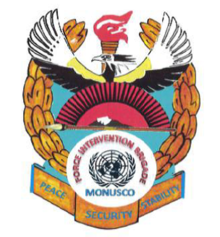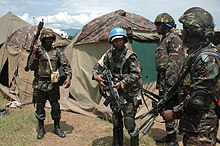The Armed Forces of the Democratic Republic of the Congo is the state organisation responsible for defending the Democratic Republic of the Congo. The FARDC was rebuilt patchily as part of the peace process which followed the end of the Second Congo War in July 2003.

The United Nations Organization Stabilization Mission in the Democratic Republic of the Congo or MONUSCO, an acronym based on its French name Mission de l'Organisation des Nations Unies pour la stabilisation en République démocratique du Congo, is a United Nations peacekeeping force in the Democratic Republic of the Congo (DRC) which was established by the United Nations Security Council in resolutions 1279 (1999) and 1291 (2000) to monitor the peace process of the Second Congo War, though much of its focus subsequently turned to the Ituri conflict, the Kivu conflict and the Dongo conflict. The mission was known as the United Nations Mission in the Democratic Republic of Congo or MONUC, an acronym of its French name Mission de l'Organisation des Nations Unies en République démocratique du Congo, until 2010.

The Allied Democratic Forces is an Islamist rebel group in Uganda and the Democratic Republic of the Congo (DRC), considered a terrorist organisation by the Ugandan government. It was originally based in western Uganda but has expanded into the neighbouring DRC. Most Ugandan ADF fighters are Muslims from the Baganda and Basoga ethnic groups.
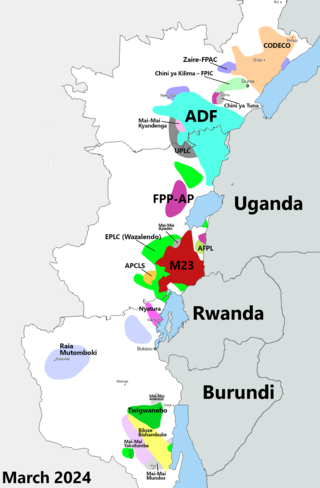
The Kivu conflict is an umbrella term for a series of protracted armed conflicts in the North Kivu and South Kivu provinces in the eastern Democratic Republic of the Congo which have occurred since the end of the Second Congo War. Including neighboring Ituri province, there are more than 120 different armed groups active in the eastern Democratic Republic of Congo. Currently, some of the most active rebel groups include the Allied Democratic Forces, the Cooperative for the Development of the Congo, the March 23 Movement, and many local Mai Mai militias. In addition to rebel groups and the governmental FARDC troops, a number of national and international organizations have intervened militarily in the conflict, including the United Nations force known as MONUSCO, and an East African Community regional force.

The M23 rebellion was an armed conflict in North Kivu, Democratic Republic of the Congo (DRC), that occurred between the March 23 Movement and government forces between 4 April 2012 and 7 November 2013. It ended when a peace agreement was made among eleven African nations, and the M23 troops surrendered in Uganda. The rebellion was part of continued fighting in the region after the formal end of the Second Congo War in 2003. The conflict reignited in late 2021 after rebel "general" Sultani Makenga and 100 rebel fighters attacked the border town of Bunagana but failed. A few months later, with a much larger force, the rebels of the M23 movement renewed their attack and captured Bunagana.
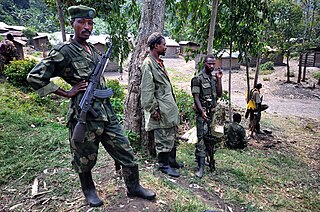
The March 23 Movement, often abbreviated as M23 and also known as the Congolese Revolutionary Army, is a Congolese rebel military group that is for the most part formed of ethnic Tutsi. Based in eastern areas of the Democratic Republic of the Congo (DRC), it operates mainly in the province of North Kivu. The M23 rebellion of 2012 to 2013 against the DRC government led to the displacement of large numbers of people. On 20 November 2012, M23 took control of Goma, a provincial capital with a population of a million people, but it was requested to evacuate it by the International Conference on the Great Lakes Region because the DRC government had finally agreed to negotiate. In late 2012, Congolese troops, along with UN troops, retook control of Goma, and M23 announced a ceasefire and said that it wanted to resume peace talks.

So far India has taken part in 49 Peacekeeping missions with a total contribution exceeding 200,000 troops and a significant number of police personnel having been deployed and more than 160 Indian peacekeepers have died serving under the UN flag as of September 2022. In 2014 India is the third largest troop contributor country [TCC] with 7,860 personnel deployed with ten UN Peacekeeping Missions of which 995 are police personnel, including the first Female Formed Police Unit under the UN. Recently Indian Peacekeepers were lauded by the UN for their efforts in preventing a carnage in the South Sudan conflict which resulted in the death of two of its soldiers.

The Allied Democratic Forces insurgency is an ongoing conflict waged by the Allied Democratic Forces in Uganda and the Democratic Republic of the Congo, against the governments of those two countries and the MONUSCO. The insurgency began in 1996, intensifying in 2013, resulting in hundreds of deaths. The ADF is known to currently control a number of hidden camps which are home to about 2,000 people; in these camps, the ADF operates as a proto-state with "an internal security service, a prison, health clinics, and an orphanage" as well as schools for boys and girls.
The Land Forces, also called the Congolese Army, are the land warfare component and the largest branch of the Armed Forces of the Democratic Republic of the Congo (FARDC).

6 South African Infantry Battalion is an air assault infantry unit of the South African Army.

United Nations Multidimensional Integrated Stabilization Mission in the Central African Republic is a UN peacekeeping mission, which started on April 10, 2014, to protect Central African Republic civilians under Chapter VII of the UN Charter. It transformed the 6,000-strong African Union-led peacekeeping force known as MISCA into a UN peacekeeping mission and became operational on September 15, 2014. The UN deployed a transition team to set up MINUSCA and prepare for a seamless transition of authority from MISCA to MINUSCA. As of 30 September 2021, it has more than 15,000 troops, police and civilian personnel on the ground. Its role is to:

Major General Jean-Lucien Bahuma Ambamba (1957–2014) was a Congolese army officer. Bahuma, described as an "exceptional soldier" by Le Potentiel and one of the Congo's "most popular and reform-minded officers" by The Economist, commanded the Armed Forces of the Democratic Republic of the Congo (FARDC) in the provinces of North and South Kivu during the M23 rebellion and Allied Democratic Forces insurgency.
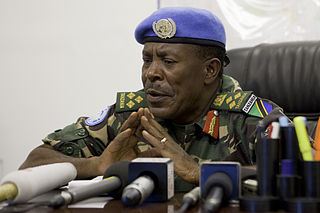
Lieutenant General James Aloizi Mwakibolwa is a Tanzanian military officer. He served as chief of staff of the Tanzania People's Defence Force (TPDF) between 2017 and 2018 and previously commanded the Force Intervention Brigade (FIB) of the United Nations' MONUSCO peacekeeping mission in the Democratic Republic of the Congo between 2013 and 2014. His command encompassed the M23 rebellion and Mwakibolwa was personally credited with making an important contribution to the defeat of the M23 rebels in Kivu Province.

The 2017 Semuliki attack was an attack carried out by elements of the Allied Democratic Forces on a United Nations Organization Stabilization Mission in the Democratic Republic of the Congo (MONUSCO) operating base in the Beni Territory, North Kivu region of the Democratic Republic of the Congo on December 7, 2017. The attack was highly coordinated and resulted in the deaths of fifteen U.N. peacekeeping personnel and wounds to 53 others making it the deadliest incident for the U.N. since the deaths of twenty-four Pakistani peacekeepers in an ambush in Somalia in 1993. The attack was among many of the latest flare-ups in violence in the North Kivu region which borders Uganda and Rwanda and one of the ADF's deadliest attacks in recent history. U.N. Secretary-General António Guterres labeled the attack, "the worst attack on UN peacekeepers in the organization's recent history."

Mamadou Mustafa Ndala was a colonel in the Armed Forces of the Democratic Republic of the Congo.

On 29 March 2022, a Puma helicopter belonging to the Pakistan Army's aviation division and assigned to the United Nations Organization Stabilization Mission in the Democratic Republic of the Congo (MONUSCO) crashed during a reconnaissance mission over the province of North Kivu, Democratic Republic of Congo. The crash killed all eight UN Peacekeepers on board, six from Pakistan and one each from Russia and Serbia.

In late March 2022, the March 23 Movement (M23) launched an offensive in North Kivu, clashing with the Armed Forces of the Democratic Republic of the Congo (FARDC) and MONUSCO. The fighting displaced hundreds of thousands of civilians and caused renewed tensions between the Democratic Republic of the Congo and Rwanda, as the latter was proved of supporting the rebel offensive.

In 2022, heavy tensions broke out between the Democratic Republic of the Congo (DRC) and Rwanda, which have led to several alleged attacks by Congolese and Rwandan forces on each other's territory. Rwandan forces have been caught crossing into the DRC multiple times, usually fighting alongside Congolese rebels.
Yusufu Eric Mboneza, more commonly called Yusuf Mboneza, is or was a Congolese military officer and rebel. During his career he served in the Rally for Congolese Democracy, the National Congress for the Defence of the People, the Armed Forces of the Democratic Republic of the Congo, and finally the March 23 Movement.

In late July 2022, anti-MONUSCO protests manifested in the Democratic Republic of the Congo. The protests were against MONUSCO, the United Nations' peacekeeping force in the country, which has been accused by Congolese politicians and civilians of failing to take action to end the decades-old conflict within the country. The protestors demanded that MONUSCO leave the country.
